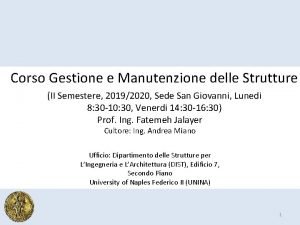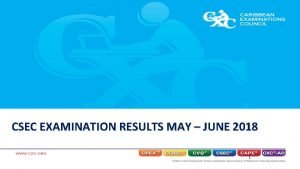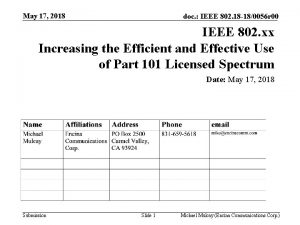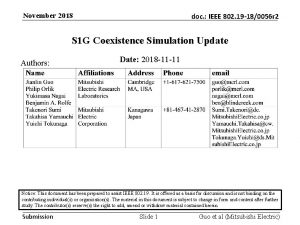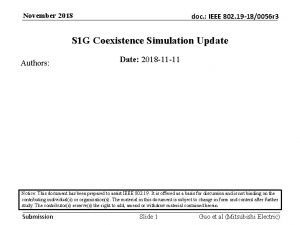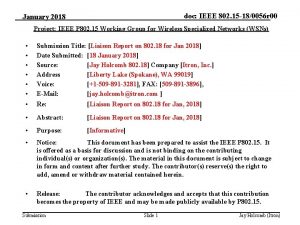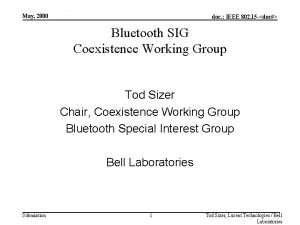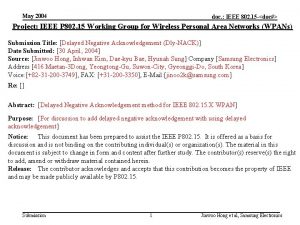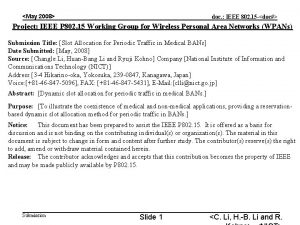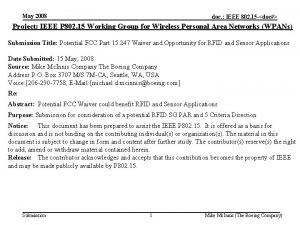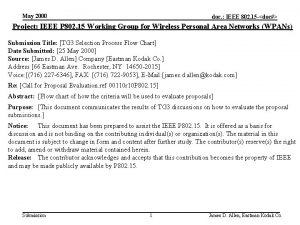May 2018 doc IEEE 802 19 180056 r














- Slides: 14

May 2018 doc. : IEEE 802. 19 -18/0056 r 0 S 1 G Coexistence Simulation Update Authors: Date: 2018 -07 -10 Notice: This document has been prepared to assist IEEE 802. 19. It is offered as a basis for discussion and is not binding on the contributing individual(s) or organization(s). The material in this document is subject to change in form and content after further study. The contributor(s) reserve(s) the right to add, amend or withdraw material contained herein. Submission Slide 1 Guo et al (Mitsubishi Electric)

May 2018 doc. : IEEE 802. 19 -18/0056 r 0 Abstract Presentation to Sub-1 GHz (S 1 G) Band Coexistence Interest Group of the IEEE 802. 19 Working Group on Simulation Update of the Coexisting IEEE 802. 15. 4 g and IEEE 802. 11 ah Using New Simulation Parameters, and Japan Regulatory on Transmission Time Control for Low Power Radio Stations (ARIB STD-T 108). Submission Slide 2 Guo et al (Mitsubishi Electric)

doc. : IEEE 802. 19 -18/0056 r 0 May 2018 Simulation Parameters • Simulation parameters are described in document [1] • 802. 15. 4 g nodes and 802. 11 ah STAs o [50, 100] • Total offered load for 802. 15. 4 g network and 802. 11 ah network o [1, 10] kb/s • Packet size o 100 bytes • Packet rate for 802. 15. 4 g network and 802. 11 ah network o [1. 25, 12. 5] packets/s • Packet rate per 802. 15. 4 g node and 802. 11 ah STA o [0. 0125, 0. 025, 0. 125, 0. 25] packet/s, i. e. , o 1 packet per [80 s, 40 s, 8 s, 4 s] • PHY data rate o 100 kb/s for 802. 15. 4 g o 300 kb/s for 802. 11 ah Submission Slide 3 Guo et al (Mitsubishi Electric)

doc. : IEEE 802. 19 -18/0056 r 0 May 2018 50 Stations and 1 Kb/s Offered Load • 802. 11 ah has no packet loss and 802. 15. 4 g has 1 packet loss • No backoff for 802. 11 ah, about 10% of re-backoff for 802. 15. 4 g Submission Slide 4 Guo et al (Mitsubishi Electric)

doc. : IEEE 802. 19 -18/0056 r 0 May 2018 50 Stations and 10 Kb/s Offered Load • 802. 11 ah has no packet loss and 802. 15. 4 g has 10 packet loss • About 6% of backoff for 802. 11 ah, about 15% of re-backoff for 802. 15. 4 g Submission Slide 5 Guo et al (Mitsubishi Electric)

doc. : IEEE 802. 19 -18/0056 r 0 May 2018 100 Stations and 1 Kbps Offered Load • No packet loss for both 802. 15. 4 g and 802. 11 ah • About 26% of backoff for 802. 11 ah, about 1% of re-backoff for 802. 15. 4 g Submission Slide 6 Guo et al (Mitsubishi Electric)

doc. : IEEE 802. 19 -18/0056 r 0 May 2018 100 Stations and 10 Kb/s Offered Load • 802. 11 ah has no packet loss and 802. 15. 4 g has 6 packet loss • More than 90% of packets delivered with at least one backoff Submission Slide 7 Guo et al (Mitsubishi Electric)

doc. : IEEE 802. 19 -18/0056 r 0 May 2018 Discussion • It is critical to maintain normal operation of the deployed 802. 15. 4 g devices • Lower rate 802. 15. 4 g was published in 2012 and higher rate 802. 11 ah was published in 2016 o Are they targeting same set of applications or different sets of applications? • What are the worst case scenarios in real applications? o o • Offered load Node density Network density Others In Japan, there is a transmission time constraint in the 920 MHz band o Can not transmit more than 360 s in arbitrary 3600 s o Is this constraint is per network or per station? Submission • Indication of the offered load Slide 8 Guo et al (Mitsubishi Electric)

doc. : IEEE 802. 19 -18/0056 r 0 May 2018 ARIB STD-T 108 Definition of Radio Equipment • A telemeter, telecontrol and data transmission radio equipment consists of radio equipment, data processing equipment and power supply equipment as shown in Figure 1 -1. This standard specifies the technical requirements of the radio equipment. Transmission Time Control Submission Slide 9 Guo et al (Mitsubishi Electric)

doc. : IEEE 802. 19 -18/0056 r 0 May 2018 Radio Station Sending Control • Consider following parameter ranges o Carrier sense time • 128 us <= carrier sense < 5 ms o Frequency band • 923. 5 -928. 1 MHz o Transmission power • 1 m. W < TX Power <= 20 m. W • Using one unit radio channel, i. e. , 200 k. Hz channel • Radio equipment shall stop its emission of radio wave less than 400 ms after it starts to emit radio wave. • The sum of emission time per arbitrary one hour shall be 360 s or less. • Meanwhile, if the emission time is more than 200 ms, it shall wait for ten times or more of the former emission time. If the emission time is more than 6 ms and is 200 ms or less, it shall wait for 2 ms for the consecutive emission. Submission Slide 10 Guo et al (Mitsubishi Electric)

doc. : IEEE 802. 19 -18/0056 r 0 May 2018 Radio Station Sending Control • Using two unit radio channels, i. e. , 400 k. Hz channel • Radio equipment shall stop its emission of radio wave less than 200 ms after it starts to emit radio wave. • The sum of emission time per arbitrary one hour shall be 360 s or less. • Meanwhile if the emission time is more than 3 ms, it shall wait for 2 ms for the consecutive emission. • Using 3, 4, or 5 unit radio channels, i. e. , 600, 800 or 1000 k. Hz channel • Radio equipment shall stop its emission of radio wave less than 100 ms after it starts to emit radio wave. • The sum of emission time per arbitrary one hour shall be 360 s or less. • Meanwhile if the emission time is more than 2 ms, it shall wait 2 ms for the consecutive emission. • Transmission time control indication o 360 s transmission constraint is for a radio equipment Submission Slide 11 Guo et al (Mitsubishi Electric)

doc. : IEEE 802. 19 -18/0056 r 0 May 2018 Skipping Carrier Sense in A Response • If the emission is a response to request by other radio equipment, and following conditions are satisfied, carrier sense is not necessary, and the response time is not included in the sum of emission time per arbitrary one hour. o Using one unit radio channel • The emission starts within 2 ms after the reception of the request is completed, and the emission ends within 50 ms. o Using 2, 3, 4, or 5 unit radio channels • The emission starts within 2 ms after the reception of the request is completed, and the emission ends within 5 ms. • ACK is a response Submission Slide 12 Guo et al (Mitsubishi Electric)

doc. : IEEE 802. 19 -18/0056 r 0 May 2018 Transmission Time Control Discussion • With 10% of duty cycle and 100 kb/s data rate, the maximum allowed offered load for an 802. 15. 4 g node is o 10 kb/s, i. e. , o about 12. 5 packets/s with packet of 100 bytes • With 10% of duty cycle and 300 kb/s data rate, the maximum allowed offered load for an 802. 11 ah STA is o 30 kb/s, i. e. , o about 37. 5 packets/s with packet of 100 bytes • Therefore, total offered load per network could be much higher than the simulated load • The key is to identify proper applications that can provide appropriate information about simulation parameters and simulation scenarios • Goal is to maintain normal function of the devices already deployed Submission Slide 13 Guo et al (Mitsubishi Electric)

doc. : IEEE 802. 19 -18/0056 r 0 May 2018 References 1. Steve Shellhamer, et. al. , “Sub-1 GHz Coexistence Simulation Parameters” IEEE 802. 19 -18/39 r 0, June 2018 2. ARIB STD-T 108 Version 1. 0, “ 920 MHz-Band Telemeter, Telecontrol and Data Transmission Radio Equipment”, February 2012 Submission Slide 14 Guo et al (Mitsubishi Electric)
 Bridges from 802.x to 802.y
Bridges from 802.x to 802.y Bridges from 802.x to 802.y
Bridges from 802.x to 802.y Ieee 802 family
Ieee 802 family Ieee 802 3 compliance
Ieee 802 3 compliance Ieee802.22
Ieee802.22 Arquitetura ieee 802
Arquitetura ieee 802 802 ieee
802 ieee Ieee 802 standard
Ieee 802 standard Bluetooth ieee 802
Bluetooth ieee 802 802 ieee
802 ieee Ieee 802
Ieee 802 Dada la siguiente secuencia rusia 2018 rusia 2018
Dada la siguiente secuencia rusia 2018 rusia 2018 Esempio calcolo vento tettoia ntc 2018
Esempio calcolo vento tettoia ntc 2018 Cxc results 2018 may/june date
Cxc results 2018 may/june date May 2018
May 2018












